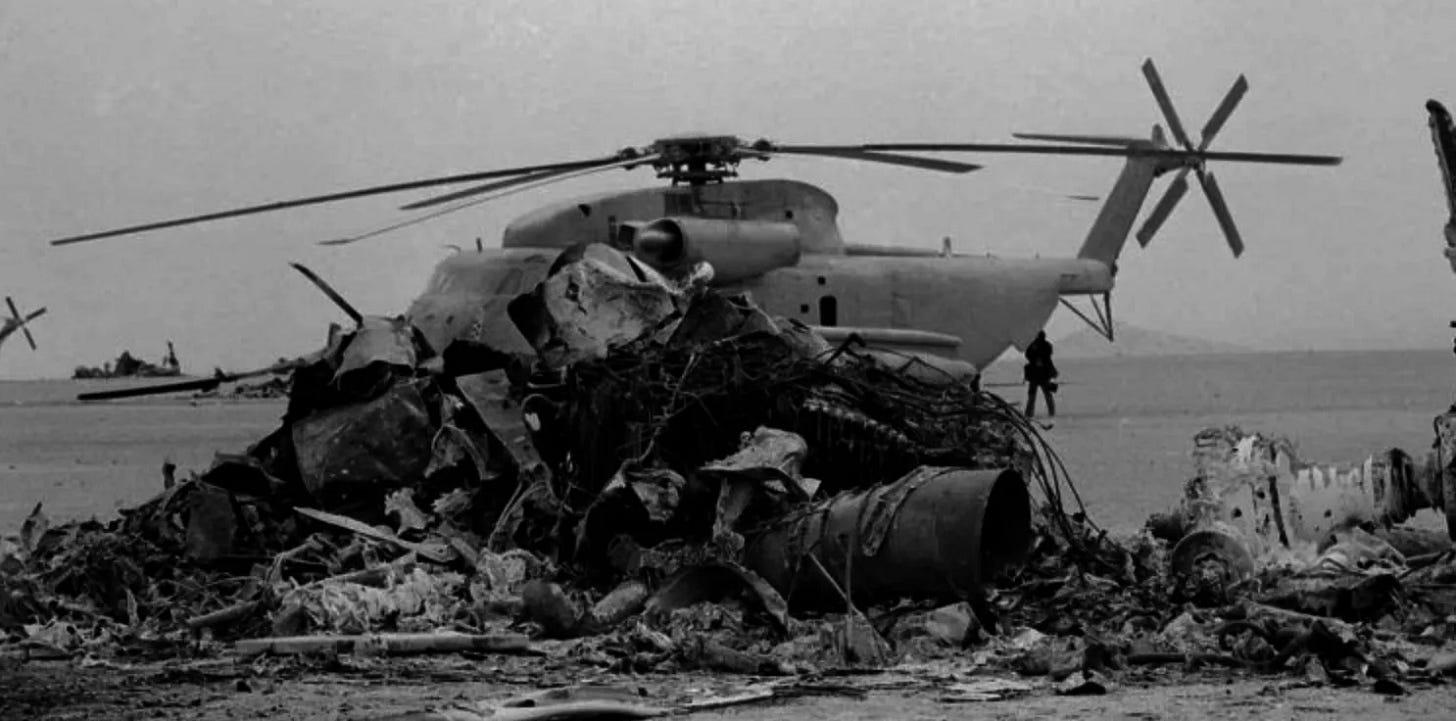Breaking the Loop: What the Failed Iran Hostage Rescue Taught Us About Fighting Cartels
Applying Lessons Learned to the War on Drugs
Jon, I hope you don’t mind me asking. But what the heck are you doing here? You’ve written about the IRS, the War on Drugs, Admiral Holsey, Howard Baker, misdirection, and The Loop. Are you barking at the moon, or are you going somewhere?
Good question, and I’m glad you asked it.
We’ve reached our destination. We’re going to see how the military escaped The Loop and reformed in the wake of Vietnam.
Desert One and the Cost of Silos
To understand it, let’s go back to the morning of April 25, 1980.
The nation awoke to the news that a rescue attempt in Iran had failed, killing eight servicemen in a fiery crash in the desert. The 52 hostages remained captive until January 20, 1981—moments after President Reagan’s inauguration—capping an embarrassing chapter of American history that echoed the futility of Vietnam.
Operation Eagle Claw was an audacious mission involving all four branches of the military. For it to succeed, everything had to go perfectly.
It didn’t.
In The Guts to Try, Colonel James Kyle chronicled the planning and execution of Eagle Claw and laid bare the reasons for failure. The pilots and operators weren’t the problem; they were dedicated professionals executing a flawed plan shaped by inter-service rivalry and bureaucratic compromise.
Mechanical failures, a blinding dust storm, outdated equipment, murky chains of command, no contingencies, poor coordination, and ultimately a fatal collision at Desert One turned the mission into tragedy.
It was a case study in institutional misalignment—exactly what Patton meant when he said all wars happen at night, in a driving rainstorm, at the intersection of four map sheets.
The Cure: Goldwater–Nichols
Congress studied the catastrophe at Desert One—and our failure in Vietnam—through the Holloway Commission Report and enacted sweeping transformation and reform. The Goldwater–Nichols Act of 1986 fundamentally changed how the nation went to war and laid the foundation for success in Panama, Desert Storm, Kosovo, and the early phase of Afghanistan.
The Goldwater–Nichols Act rewired the system and delivered:
A unified chain of command
True joint operations
A strengthened Chairman of the Joint Chiefs
Coherent strategic planning
Empowered geographically focused Combatant Commands
The Mutating Virus: Afghanistan
But The Loop is like a virus—it infects every institution it touches and mutates to survive reform.
Afghanistan proved the point. Operationally, the machine worked: special operations, joint targeting, air support, and inter-service coordination all functioned as designed. That’s Goldwater–Nichols succeeding.
And yet the system failed the people doing the fighting.
Once again, servicemen and women did their jobs with valor. But their sacrifice was harnessed to an ill-conceived, incoherent, profit-driven national strategy sustained across four administrations.
Twenty years.
$2.3 trillion.
Thousands of American dead.
Thousands more wounded.
Hundreds of thousands of Afghan lives lost.
Meanwhile, contractors and weapons manufacturers recorded record profits. The strategic mission failed because The Loop captured the contracting and policy-making processes.
Goldwater–Nichols teaches us two things:
Structural reform can force coordination.
Even then, The Loop mutates unless you measure outcomes and kill failing programs.
You inoculate institutions with clear metrics, strict success criteria, and mechanisms to cut ineffective efforts. Otherwise, the virus adapts and spreads.
We’ve Applied These Lessons Before—But Not Everywhere
After 9/11, we discovered that intelligence agencies were sitting on pieces of the same puzzle, unable or unwilling to share. We created the Director of National Intelligence, integrated the system, and for two decades have avoided another major international terrorist attack.
So why haven’t we applied similar reforms to the War on Drugs?
The answer: The Loop.
The Coordination Problem Is Endemic
The same dysfunction Colonel Holder taught me about in Germany—the fatal cost of poor coordination—is alive and well in the drug war.
Seven domains.
No unified command.
Every agency guarding its turf and budget.
DEA, FBI, Coast Guard, CBP, ATF, Treasury, HHS, State Department—each fighting their slice of the problem while cartels exploit the gaps between them.
Unlike the military, the drug war has no Goldwater–Nichols.
Nobody owns the mission.
And tragically, The Loop ensures nobody wants to.
What Loop-Breaking Reform Would Look Like
1. Unified Command and Coordination
Create an NSC-level Drug War Directorate with authority across seven domains:
Intelligence: CIA, DEA Intelligence, NSA
Interdiction: Coast Guard, Navy, CBP
Enforcement: DEA, FBI, ATF
Diplomacy: State Department
Economic Crimes: Treasury, IRS
Health & Treatment: HHS, SAMHSA, CDC
Development: USAID
Just as Goldwater–Nichols forced the services to fight as one team, this would force agencies to operate as a unified system. Cartels exploit our dysfunction as they coordinate seamlessly across domains and borders. We operate in silos. That ends.
2. Accountability Through Transparency
Elevate the Office of National Drug Control Policy to a Senate-confirmed cabinet position with a seat on the NSC.
Require an annual strategic plan with measurable objectives and a public scorecard tracking:
Overdose deaths
Treatment capacity
Cartel revenue disruption
Precursor chemical interdiction
Corruption prosecutions
Make failure visible. Force accountability.
3. Budget Authority and Performance-Based Contracting
Give the Directorate the power to reallocate funding from programs that fail to those that deliver results.
If a contractor is paid to reduce trafficking and trafficking rises, the contract ends.
If a treatment program doesn’t reduce overdoses, funding shifts to one that does.
Contractors should profit from success—not perpetuation.
We’ve Done This Before. We Can Do It Again.
After Eagle Claw, we reformed.
After 9/11, we reformed.
We know how to do this. The blueprint exists.
So why not build a coordinated, metrics-driven national strategy to hit the drug crisis on every front: interdiction, enforcement, treatment, and economic development?
107,000 Americans died from overdoses last year. How many more must die in an ill-conceived, ineptly led, profit-driven war on drugs before we break The Loop?



